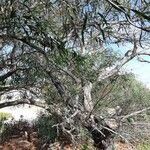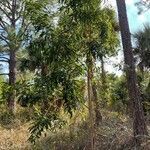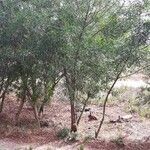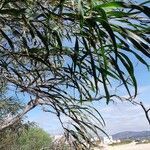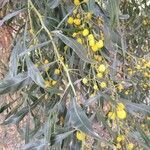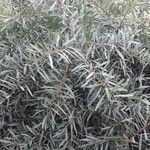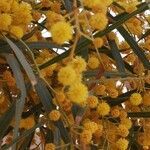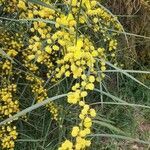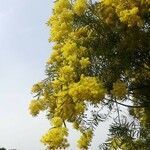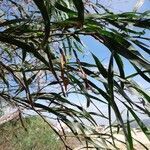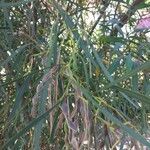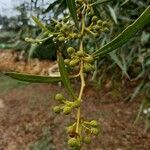An evergreen tree. It grows to 6 m high and 3 m across. The stem is erect and slender. It has an open textured crown. The small branches are often angular and hand downwards. They are reddish brown when young. The leaves (phyllodes) are greyish green with a single prominent vein. They are 10-20 cm long and 0.3-1.5 cm wide. They are curved and narrowed at the base. Sometimes they have a tip which curves backwards. The flowers are small clusters in the angles where leaves join the branch. These flower clusters are 2-4 cm long. They are small yellow balls. There are 6-20 flower heads in a cluster. The pods are brown. They are usually straight and flat. They are not constricted between the seeds. They are 6-20 cm long and 0.6-1 cm across. They are edible. The seed has a skin like layer around it.
Unarmed, erect, often very much-branched shrub, 1-5 m high. Branchlets trigonous at the apex, when older ribbed, usually glabrous. Phyllodes lanceolate-linear, sometimes wider above the middle, with one vein, finely penniveined, 2-22 by 1(—1.3) cm, glaucous, marginal gland above the base, rarely wanting. Flowering heads composed of 30-50 flowers grouped into axillary, erecto-patent racemes, almost always branched. Flowers light yellow, pentamerous, bisexual. Pod linear, straight or slightly curved, flat, 7.5-20 by 0.8-1 cm. Seeds longitudinal, oblong, funicle dilated, extending round the seed and bent back on the same side, encircling it into a double fold.
Unarmed glabrous shrub or small tree. Leaves phyllodic, apparently simple, linear-lanceolate to-oblong or oblanceolate, straight or slightly curved, 4.5-17 cm long, up to 1.5 cm wide, narrowing gradually towards the base, with a single main longitudinal nerve and finely but distinctly penninerved. Flowers in round heads up to 6 mm in diameter; inflorescences on peduncles 3-6 mm long, arranged in short axillary racemes. Pods 7-12 x 0.5-0.7 cm, linear-oblong, flattened, longitudinally dehiscent; funicle encircling the seed in a double fold.
